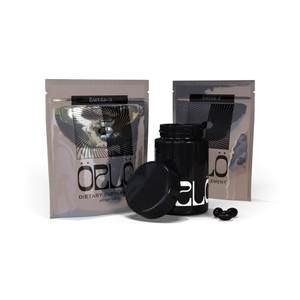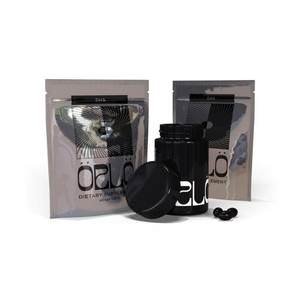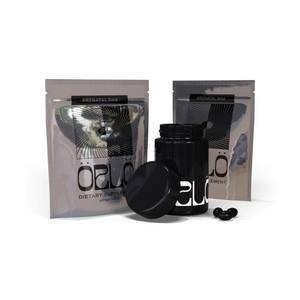Isaac Berzin Discusses Vegan Omega-3 Supplements
Did you know omega-3 fatty acids are used for every cell in our bodies?! This makes finding adequate vegan sources of this nutrient an absolute must. What if we told you there was a carbon negative algae-based omega-3 supplement alternative with three times the bioavailability of its fish oil counterpart? Keep reading to learn more!
The Need for a Better Omega-3 Alternative
At this point, there's no hiding the fact that overfishing is destroying our oceans. Did you know that just in North America, about 300,000 metric tons of fish oil are produced in a year? And just one month's supply of fish oil supplements for one consumer requires the lives of 110 small pelagic fish!
Why is this so harmful to our planet? Firstly, fish that die naturally in the ocean will sink to the sea floor and release their sequestered carbon, which is then absorbed by microbes and other sea creatures. Meanwhile, if they're out of water when this happens, they will instead release carbon into the atmosphere, further contributing to global warming. This is the last thing we need!
In addition, fish oil manufacturing requires a lot of energy and carbon. In fact, each metric ton produced requires about 35 tons of CO2-equivalent.
Orlo Nutrition's Algae Omega 3 Supplements
This is where brands like Örlö Nutrition come in. Örlö wants to keep fish in the oceans, and instead source omegas from a vertical algae farm in Iceland to produce their eco-friendly fish oil alternative! They use a regenerative production process with 100% renewable energy powered by biotech firm Vaxa Technologies. Through this method they are able to use 99% less water and land than standard omega-3 supplement companies.
Additionally, with their controlled environment, Vaxa is able to optimize their algae's growth conditions, reducing waste, inconsistency, and the risk of contamination.
Why Algae?
The big question is, where do fish get their omega-3s? The answer is, from algae! And the great news is, this plant sequesters carbon from our atmosphere, making it a great tool to help fight global warming.
This info makes algae a no-brainer; it's a direct source of omega-3s, and a much more logical, environmentally-safe swap!
Our Exclusive Interview with Founder & CTO of Vaxa Technologies, Professor Isaac Berzin
OV: What interested you initially in algae as a sustainable source of nutrition?
IB: The following thought: All nutrition comes from light (converted by plants, at the base of food chain). Microalgae have a much larger yield when compared to other staples like corn, with virtually no waste.
OV: What made Iceland the right choice for the geothermal power plant?
IB: The Icelandic ecosystem, with clean Geothermal energy (heat and electricity), pristine water and natural CO2 sources, enables sustainable and cost effective vertical farming of algae. It is the only carbon-neutral algal cultivation in the world.
OV: Who would you recommend Örlö's Omega-3 supplement for?
IB: Örlö’s omega-3 products contain both EPA and DHA, providing fundamental nutritional support for the 37 trillion cells in your body, making them ideal for just about everyone. This is because each cell requires EPA and DHA for optimal function, but getting enough of these essential fatty acids from your diet is problematic at best. Given Örlö’s highly bioavailable polar lipid form, the EPA and DHA provided are quickly integrated into your tissues, supporting your cardiovascular system, brain and eye health, joint comfort, and immune system function – and at a lower dose than would be required with fish oil or other algae oils.
Omega-3: Provides a balanced and direct source of the omega-3 EPA and DHA for a healthy heart, joints, immune system and a normal inflammatory response.
DHA/Prenatal DHA: Provides a higher potency of the omega-3 DHA with EPA for support of brain and eye health, attention and focus, and skin health.
OV: What would you say is the main reason fish oil takes so much more carbon and energy to produce than algae oil?
IB: Fish oil based Omega 3 production includes several energy/carbon intensive steps:
Catching the fish: Carbon cost of actually getting to the fish (diesel engines of shipping vessels)
Squeezing the oil out: Centrifuge with heating of fish to remove oil, then separate from other liquids through a saponification process
Refining the oil: Energy intensive refinement of the oil using high heat to separate the constituents by molecular weight, concentrating for EPA and DHA while eliminating toxic impurities including heavy metals like lead and mercury, dioxins, furans, and flame retardants.
Winterization (cooling) to remove oleic and stearic acids to prevent cloudiness of the oil
Filtration to remove any remaining solid matter
Chemical processing: Once concentration and purification is complete, you need to further process the oil, adding back the glycerol backbone using enzymes – or it will remain in the inferior esterified form as ethyl esters. This is what it means to “re-esterify” a triglyceride, which is often abbreviated as rTG.
In addition, the procurement and refining of fish oil is expensive from both a life cost and carbon cost due to logistical issues. Most of the fish used in fish oil comes from the Peruvian Anchoveta which is then transported for refinement in Norway or China. From there it must be separated from solid matter, refined to remove toxins including mercury, dioxins, furans, and flame retardants. Processing uses solvents, high heat, intense cooling, and enzymatic processes all of which are energy intensive.
When you compare this to what we do for Örlö Nutrition products, the difference is clear. We minimally process our oils using only organic ethanol and water as solvents. Our oil retains its polar lipid structure due to a minimal need for processing. That minimal need comes from the pure inputs, no use of pesticides, herbicides or fungicides, and no exposure to environmental pollutants.
OV: You state on the Vaxa website that there is less of a risk of contamination with your unique production process. Did you find that there is a high risk of contamination for conventionally-grown algae supplements? How do the contaminant levels in algae supplements compare to those of fish oil supplements?
IB: When you cultivate microalgae in an open pond you never have a pure culture, and you do not really control the other species co-growing there. Whatever the wind blows, whatever the rain brings – it could all grow in the pond. The issue is that some algal strains are highly toxic (e.g. neurotoxins) even in small amounts, so the risk is always there.
OV: There is a popular study that has claimed we will see fishless oceans by 2048. Does this concur with your research and data?
IB: Yes, the Monterey Bay Area Research Institute (MBARI) has shared for almost 2 decades that the rising acidity of our oceans could mean our oceans don’t support life any longer by 2050 – and they have even acknowledged that their reporting has been conservative. Our oceans continue to become more acidic because there is more carbon in our atmosphere, and our oceans are our largest carbon sink. As the ocean absorbs more carbon, its temperature and acidity both rise, posing huge problems for aquatic life. We are already seeing die off of mollusk species, and coral reefs. These are like the canaries in the coal mine. We have to stop the progression of ocean life loss, and one way to do that is to support the development of vast marine sanctuaries, while also developing renewed strategies to sequester carbon. Many innovators in the space of algae are undertaking this call, and we are providing one such solution.
OV: We understand the aquaculture planthouse uses machine learning technology for its year-round production. Could you take us through a few of the functions these machines carry out?
IB: Optimizing algal growth conditions for Omega-3 production is a multi-parameter equation. Since our cultivation technology allows a tight control and the option for changing each condition independently (e.g. pH, temperature, light intensity, light composition, photo-modulation, salinity) we are using machine learning to understand this non-linear relationship.
OV: Do you envision Örlö expanding beyond omega-3, D3, and B-complex supplements in the near future?
IB: One of the most amazing things we recently discovered is that our Icelandic Ultra Spirulina contains the most bioavailable form of vitamin B12, methyl cobalamin. This is big news as Spirulina grown outdoors in sunlight contains mainly pseudo-B12, a form that has no nutritional benefits and which can actually block your B12 receptors. As a result, Spirulina grown in open ponds can actually rob your system of B12, introducing deficiency, while that produced by Örlö provides more B12 than would traditionally be found in beef. This is great news for vegetarians and vegans who are notoriously deficient in this core nutrient. This discovery opens the door for an Icelandic Ultra Spirulina product that contains a complete nutritional package: Essential amino-acids, Vitamins (including bioavailable B12 !!!) and minerals (including bioavailable Iron). We look forward to expanding our product portfolio in 2023 and beyond.
OV: Although we can't deny the benefits of an algae oil supplement, the price point still seems to be much higher than that of standard fish oil supplements. Do you believe planet-friendly algae-oil supplements will soon be able to hit the shelves globally at a competitive price?
IB: While it is true you can get a basic, low grade fish oil product for a low cost, high-quality fish oils hover around $1 a day. Given that, Örlö Nutrition’s omega-3s are already competitive. While fish oils may deliver a bigger capsule for $1 a day, we deliver 3x the absorption, which means you can get the same effect in a smaller pill. Given that, we really are already competitive in price and function.
OV: Do you think algae oil supplements will eventually become the norm for the omega-3 supplement industry?
IB: Yes. Statistics show that algal EPA and DHA are outpacing fish oils for growth in the omega-3 sector. They are even being used in aquaculture in place of fish oils to ensure that farmed fish retain more omega-3 than omega-6 in their flesh. While it will take time for people to see that algae is a cool superfood and powerhouse, the aquaculture and nutrition industries are already catching on, and with their rising adoption, the public naturally follows. Only those who enjoy fishy burps, would probably stick with fish-based omega-3s.











